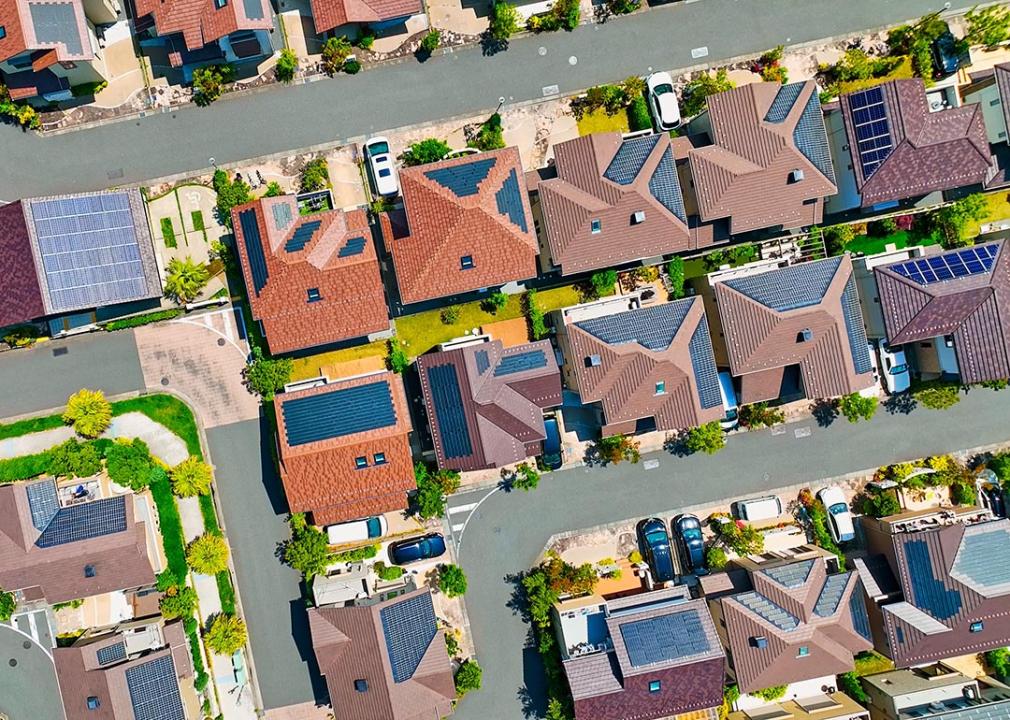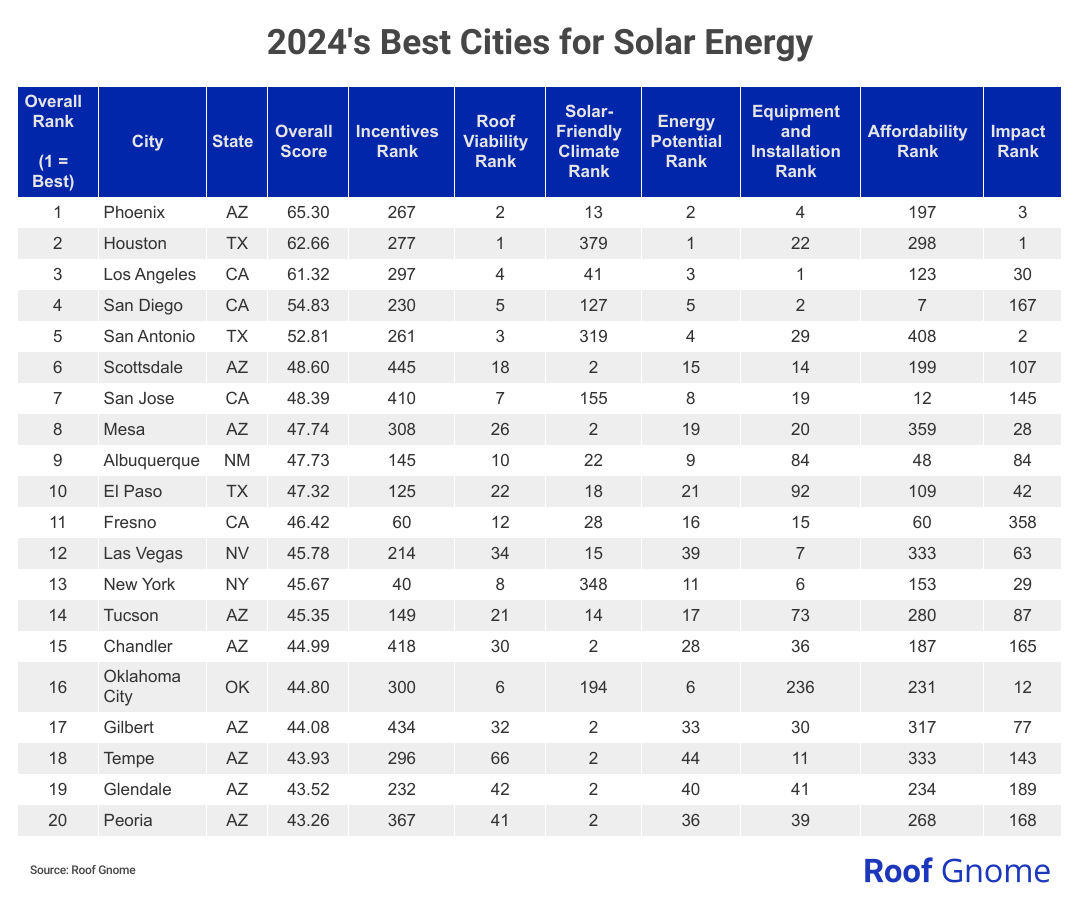Is your roof ready for solar energy in 2024?

metamorworks // Shutterstock
Is your roof ready for solar energy in 2024?
aerial view of residential solar
National solar capacity reached record growth in 2023, but which U.S. cities lead the way in solar power potential?
To mark Solar Week — observed the last full week of March — Roof Gnome ranked this year’s best cities for solar energy.
This analysis compared over 470 of the biggest U.S. cities based on the solar viability of their roofs, potential solar energy production, as well as projected financial and environmental impact. We also measured average grid energy prices, access to solar equipment and services, and time to recoup solar investments, among 17 total metrics.
See which cities outshine the others below. To learn more about how the cities were ranked, check out the methodology.
![]()

Roof Gnome
Rankings: Spotlighting the top 5 and other city highlights
table showing top 20 cities for best solar energy
See how each city fared in the rankings.
In the spotlight: Top 5 cities
1: Phoenix | Overall Score: 65.30
- Total Square Footage of Solar-Viable Roofs: 635 Million | Rank: 4
- Historical Annual Average Percentage of Sunshine: 85.75% | Rank: 1
- Total Yearly Energy Generation Potential (MWh AC): 14.4 Million | Rank: 3
- Number of Solar Equipment Dealers: 80 | Rank: 5
- Total Metric Tons of Potentially Avoided CO2 Emissions: 9.1 Million | Rank: 2
2: Houston | Overall Score: 62.66
- Total Square Footage of Solar-Viable Roofs: 1 Billion | Rank: 1
- Total Yearly Energy Generation Potential (MWh AC): 18.5 Million | Rank: 1
- Total Installation Capacity (MW DC): 14,500 | Rank: 1
- Number of Solar Equipment Dealers: 87 | Rank: 4
- Total Metric Tons of Potentially Avoided CO2 Emissions: 11.8 Million | Rank: 1
3: Los Angeles | Overall Score: 61.32
- Total Number of Solar-Viable Roofs: 655,000 | Rank: 1
- Historical Annual Average Number of Cloudy Days: 73 | Rank: 15
- Total Yearly Energy Generation Potential (MWh AC): 15.6 Million | Rank: 2
- Number of Solar Equipment Contractors Within 10 Miles: 67 | Rank: 2
- Total Metric Tons of Potentially Avoided CO2 Emissions: 6.7 Million | Rank: 4
4: San Diego | Overall Score: 54.83
- Total Number of Solar-Viable Roofs: 301,000 | Rank: 7
- Total Installation Capacity (MW DC): 5,900 | Rank: 7
- Total Yearly Energy Generation Potential (MWh AC): 8.9 Million | Rank: 5
- Net Cost of System After Rebates and Incentives: $9,176 | Rank: 8
- Total Metric Tons of Potentially Avoided CO2 Emissions: 3.8 Million | Rank: 17
5: San Antonio | Overall Score: 52.81
- Total Square Footage of Solar-Viable Roofs: 651 Million | Rank: 3
- Total Installation Capacity (MW DC): 9,200 | Rank: 3
- Total Yearly Energy Generation Potential (MWh AC): 12.1 Million | Rank: 4
- Total Cost of Utility Power Avoided Over 25 Years: $68,858 | Rank: 58
- Total Metric Tons of Potentially Avoided CO2 Emissions: 7.7 Million | Rank: 3
Highlights and lowlights
Unsurprisingly, the sunniest U.S. cities dominated the ranking.
Phoenix — aptly nicknamed “Valley of the Sun” — is the solar promised land, along with other sunshine-rich cities like Los Angeles (No. 3) and El Paso, Texas (No. 10). Both roof viability and energy potential run high among these top performers.
On the other hand, cities with less solar-friendly climates might seem like poor candidates for solar power.
However, Google’s Project Sunroof data identified extensive infrastructure in cities like New York (No. 13), Chicago (No. 48), and Indianapolis (No. 107) to support solar energy production. The proliferation of equipment dealers and installers here also suggests widespread adoption of the technology.
Except for Seattle at No. 365, Washington state’s Puget Sound region makes up nearly all of the worst 10 cities in the ranking. Redmond, a Seattle suburb, placed last overall.
One caveat: “Worst” is a bit of a misnomer in this case. Clouds dominate the skies in this region much of the year, slightly diminishing solar panels’ effectiveness. However, Puget Sound residents already enjoy the nation’s most affordable electricity, nearly all of which is generated from renewable resources.
Methodology: Behind the ranking
First, the factors (metrics) that are most relevant to rank the best cities for solar energy were determined. Each factor was assigned a weight based on its importance and those factors were grouped into seven categories:
- Incentives
- Roof Viability
- Solar-friendly Climate
- Energy Potential
- Equipment and Installation
- Affordability
- Impact
The factors making up each category, along with their weights, are listed here. For each of the 500 biggest U.S. cities, data was gathered on each factor from Electricity Local, EnergySage, Google Project Sunroof, Houzz, National Oceanic and Atmospheric Administration, SolarReviews, and Yellow Pages. There were 26 cities lacking sufficient data in a single category, resulting in a final sample size of 474 cities.
Finally, scores were calculated (out of 100 points) for each city to determine its rank in each factor, each category, and overall. A city’s Overall Score is the average of its scores across all factors and categories. The highest Overall Score ranked “Best” (No. 1) and the lowest “Worst” (No. 474). Note: The “Worst” among individual factors may not be No. 474 due to ties.
Final thoughts: Make the most of your solar panels
As of 2023, some 4.5 million (out of 131 million) U.S. households have installed photovoltaic (PV) panels on their roofs — though the nation’s total solar capacity actually could power up to 33 million homes.
With solar panels, that means millions of homeowners are seeing their utility bills drop — all while rescuing the planet.
With a solar energy system, a typical homeowner saves 40% to 70% a year on their energy bill.
Plus, solar panels are about $15,000 cheaper today than in 2010, not to mention all the incentives and rebates available to offset initial costs.
To help ease your transition to solar, follow these helpful tips:
- First of all, find out if your house is even a good candidate for solar panels, and learn what factors to consider when switching to solar.
- Solar panel costs and solar roof costs vary widely based on the size of your home’s needs and other factors. Minimize your up-front expenses by exploring different ways to finance your solar panels.
- Find out how solar panel efficiency is calculated to help you choose the right solar panels for your home.
- Install your new solar system between fall and spring so your home can begin generating solar electricity in summer, but make sure you choose an experienced solar panel installer.
- Like any other part of your home, solar panels need regular maintenance to work at their best. Understand how to care for your solar panels.
This story was produced by Roof Gnome and reviewed and distributed by Stacker Media.





